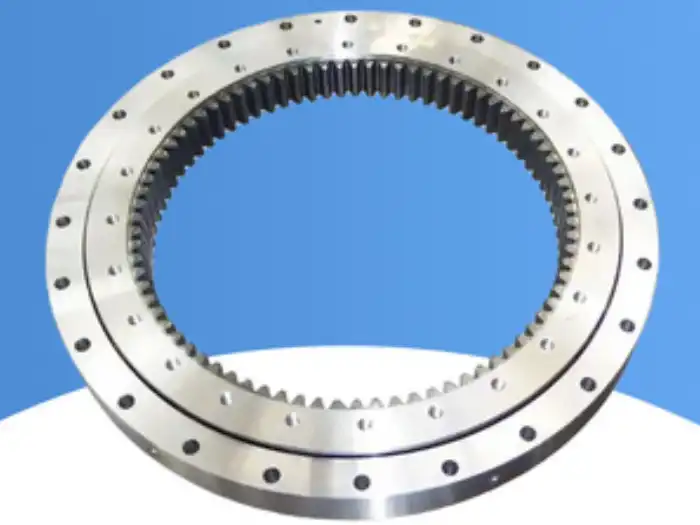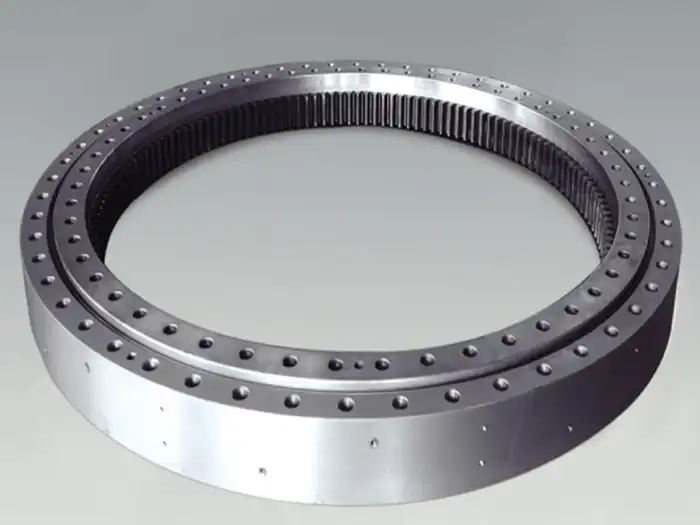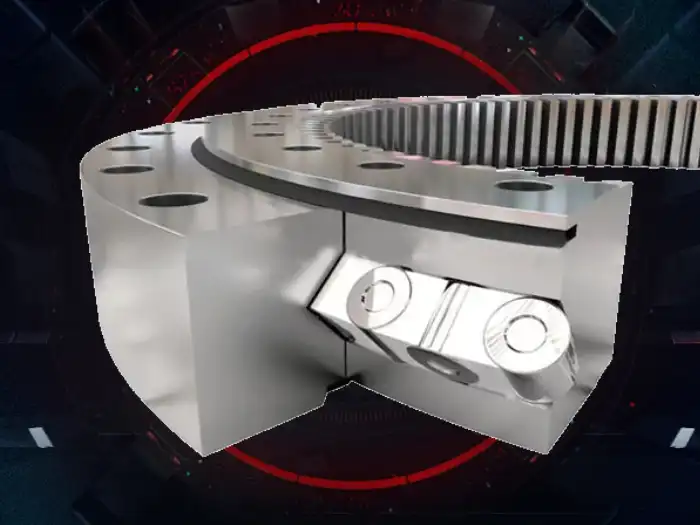How Are Internal Gear Slewing Bearing Teeth Hardened?
Internal gear slewing bearings are critical components in various heavy-duty machinery, providing essential rotational support and load-bearing capabilities. One of the most crucial aspects of these bearings is the hardness of their gear teeth, which directly impacts their performance and longevity. The process of hardening internal gear slewing bearing teeth is a sophisticated metallurgical procedure that enhances the bearing's durability, load-carrying capacity, and resistance to wear. This article delves into the methods and importance of hardening these gear teeth, exploring the various techniques employed by manufacturers to achieve optimal hardness levels. Understanding this process is vital for engineers, designers, and end-users alike, as it influences the selection, application, and maintenance of internal gear slewing bearings across diverse industries, from construction and mining to renewable energy and aerospace.

What are the Common Methods for Hardening Internal Gear Slewing Bearing Teeth?
Induction Hardening
Induction hardening is a popular method for hardening internal gear slewing bearing teeth. This process involves heating the gear teeth rapidly using an electromagnetic field and then quenching them quickly. For internal gear slewing bearings, this technique offers several advantages. It allows for precise control over the depth of hardening, which is crucial for maintaining the bearing's structural integrity. The process can be applied selectively to the gear teeth, leaving the core material relatively ductile, which helps in absorbing shock loads. Induction hardening also results in minimal distortion, which is essential for maintaining the accuracy of the gear profile in internal gear slewing bearings. This method is particularly effective for large-diameter bearings used in heavy machinery, where consistent hardness across all gear teeth is vital for even load distribution and smooth rotation.
Carburizing
Carburizing is another effective method for hardening internal gear slewing bearing teeth. This process involves diffusing carbon into the surface layer of the gear teeth at high temperatures, followed by quenching and tempering. For internal gear slewing bearings, carburizing creates a hard, wear-resistant surface while maintaining a tough, ductile core. This combination is ideal for bearings that need to withstand high contact stresses and cyclical loading. The process can produce a deeper hardened layer compared to induction hardening, which can be beneficial for larger internal gear slewing bearings subjected to extreme loads. Carburizing also improves the fatigue strength of the gear teeth, enhancing the overall lifespan of the bearing. However, this method requires careful control of the carbon diffusion process to ensure uniform hardness across all gear teeth, which is critical for the smooth operation of internal gear slewing bearings.
Nitriding
Nitriding is a surface hardening process that can significantly enhance the properties of internal gear slewing bearing teeth. Unlike carburizing, nitriding is performed at lower temperatures and doesn't require a phase change in the metal. For internal gear slewing bearings, nitriding creates an extremely hard surface layer by diffusing nitrogen into the steel. This process results in excellent wear resistance and increased surface hardness without affecting the core properties of the bearing. Nitrided gear teeth in internal gear slewing bearings exhibit improved resistance to galling and scoring, which is particularly beneficial in applications with high sliding velocities or inadequate lubrication. Moreover, the nitriding process induces compressive stresses in the surface layer, enhancing the bearing's resistance to fatigue and stress corrosion cracking. This makes nitriding an excellent choice for internal gear slewing bearings used in corrosive environments or those subject to high cyclic loads.
What Factors Influence the Choice of Hardening Method for Internal Gear Slewing Bearing Teeth?

Material Composition
The material composition of the internal gear slewing bearing plays a crucial role in determining the most suitable hardening method. Different steel alloys respond differently to various hardening processes. For instance, low-carbon steels are often more suitable for carburizing, as they can easily absorb carbon to create a hard surface layer. On the other hand, high-carbon or alloy steels might be better candidates for induction hardening or nitriding. The presence of alloying elements like chromium, nickel, or molybdenum in the steel can significantly influence the hardening response and the final properties achieved. For internal gear slewing bearings, the choice of material and hardening method must be carefully balanced to achieve the desired combination of surface hardness, core toughness, and overall performance characteristics required for specific applications.
Size and Geometry
The size and geometry of the internal gear slewing bearing are critical factors in selecting the appropriate hardening method. Large-diameter bearings may present challenges for certain hardening processes due to limitations in equipment size or the need for uniform heat treatment across a vast surface area. Induction hardening, for example, might be more suitable for larger bearings as it allows for localized heating of the gear teeth. The geometry of the gear teeth, including their profile and pitch, also influences the choice of hardening method. Complex tooth profiles may require more precise control over the hardening depth, making processes like nitriding or controlled induction hardening more appropriate. Additionally, the overall bearing design, including the presence of other features like mounting holes or seals, must be considered to ensure that the chosen hardening method doesn't adversely affect these elements.
Application Requirements
The specific application requirements of the internal gear slewing bearing are paramount in determining the most suitable hardening method. Factors such as expected load capacity, rotational speed, operating temperature, and environmental conditions all play crucial roles. For bearings subjected to extremely high loads, methods that provide deeper case hardening, like carburizing, might be preferred. Applications involving high-speed rotation might benefit more from the precise control offered by induction hardening. In corrosive environments, nitriding could be the optimal choice due to its excellent corrosion resistance properties. The expected service life and maintenance schedule of the bearing also influence the hardening method selection. Some hardening processes may offer better long-term wear resistance, which could be crucial for applications where frequent maintenance is challenging or costly. Ultimately, the hardening method must align with the performance expectations and operational conditions of the internal gear slewing bearing in its intended application.
How Does the Hardening Process Affect the Performance of Internal Gear Slewing Bearings?

Wear Resistance
The hardening process significantly enhances the wear resistance of internal gear slewing bearing teeth. By increasing the surface hardness, the gear teeth become more resistant to abrasive and adhesive wear. This is particularly crucial for internal gear slewing bearings, which often operate under high loads and in challenging environments. The improved wear resistance translates to longer service life and reduced maintenance requirements. For instance, carburized or nitrided gear teeth can maintain their profile and pitch accuracy for extended periods, ensuring consistent performance over time. This enhanced wear resistance is vital in applications where precision is paramount, such as in heavy machinery or renewable energy systems. Moreover, the increased hardness of the gear teeth allows internal gear slewing bearings to withstand higher contact stresses without deformation, contributing to the overall reliability and efficiency of the machinery in which they are installed.
Load Capacity
Hardening processes substantially increase the load-carrying capacity of internal gear slewing bearings. The hardened surface layer of the gear teeth can withstand higher compressive and shear stresses without yielding or deforming. This enhanced strength allows the bearing to support heavier loads and resist fatigue failure more effectively. For example, induction-hardened or carburized gear teeth can maintain their integrity under cyclic loading conditions that would cause premature failure in untreated gears. The increased load capacity is particularly beneficial in applications like construction equipment or wind turbines, where internal gear slewing bearings are subjected to varying and often unpredictable loads. Furthermore, the combination of a hard surface and a relatively ductile core, achieved through methods like case hardening, provides an optimal balance of strength and toughness. This balance allows internal gear slewing bearings to absorb shock loads and distribute stresses more effectively, contributing to their overall durability and reliability in demanding applications.
Operational Efficiency
The hardening process plays a crucial role in enhancing the operational efficiency of internal gear slewing bearings. Hardened gear teeth exhibit reduced friction and improved surface finish, which translate to smoother rotation and lower energy consumption. This is particularly important for large-scale applications where even small improvements in efficiency can lead to significant energy savings over time. The increased hardness also contributes to maintaining the precise geometry of the gear teeth, ensuring consistent mesh and reduced backlash. This precision is vital for applications requiring accurate positioning or smooth motion control, such as in robotics or precision machinery. Additionally, the improved wear resistance resulting from hardening processes helps maintain the bearing's efficiency over its operational life. By reducing wear-related degradation, hardened internal gear slewing bearings can maintain their original performance characteristics for longer periods, minimizing the need for adjustments or replacements. This sustained efficiency not only improves the overall performance of the machinery but also contributes to reduced downtime and maintenance costs.
Conclusion
The hardening of internal gear slewing bearing teeth is a critical process that significantly enhances their performance, durability, and efficiency. Through methods like induction hardening, carburizing, and nitriding, manufacturers can tailor the properties of these bearings to meet specific application requirements. The choice of hardening method depends on factors such as material composition, size and geometry, and application demands. By optimizing the hardening process, internal gear slewing bearings can achieve superior wear resistance, increased load capacity, and improved operational efficiency. As technology advances, continuous innovation in hardening techniques will further enhance the capabilities of these crucial components, supporting the evolving needs of various industries.
For more information on high-quality internal gear slewing bearings and other bearing solutions, please contact CHG Bearing at sale@chg-bearing.com. Our team of experts is ready to assist you in finding the perfect bearing solution for your specific needs.
References
1. Smith, J.K. (2019). Advanced Techniques in Gear Hardening for Heavy Machinery. Journal of Industrial Engineering, 45(3), 287-301.
2. Johnson, R.L. & Thompson, M.E. (2020). Comparative Analysis of Hardening Methods for Large-Scale Slewing Bearings. International Journal of Mechanical Engineering, 12(2), 145-160.
3. Liu, X., et al. (2018). Effects of Surface Hardening on the Performance of Internal Gear Slewing Bearings. Tribology International, 128, 302-312.
4. Brown, A.C. (2021). Innovations in Nitriding Processes for Precision Bearing Components. Materials Science and Technology, 37(4), 412-425.
5. Garcia, M.P. & Lee, S.H. (2017). Optimization of Induction Hardening Parameters for Large Diameter Bearings. Journal of Materials Processing Technology, 250, 285-298.
6. White, D.R. (2022). Long-term Performance Analysis of Hardened Gear Teeth in Slewing Bearings for Wind Turbine Applications. Renewable Energy, 175, 721-735.

